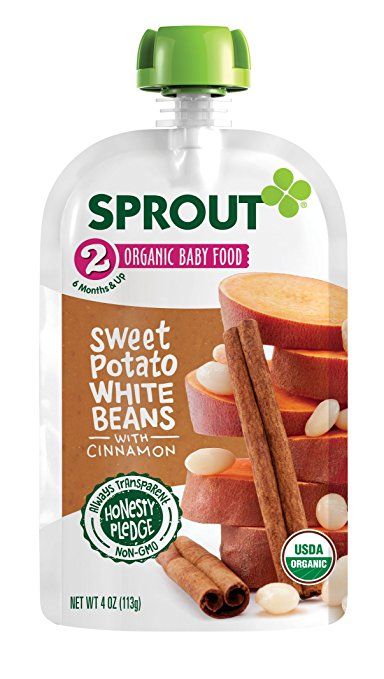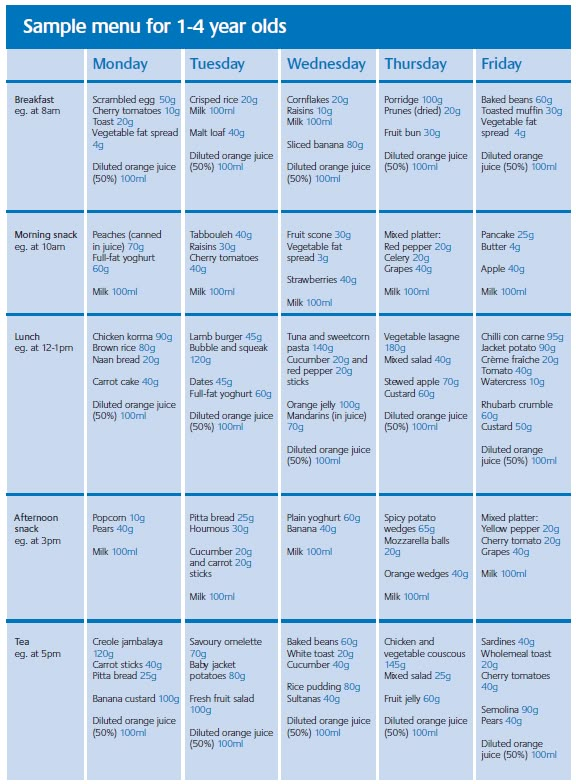Table foods to start feeding baby
Giving Baby Finger Foods at 7-8 Months
Written by Rebecca Felsenthal Stewart
In this Article
- Month 7, Week 3
- Month 7 Week 3 Tips
Month 7, Week 3
Once your baby is a pro at eating soft mashed foods, they may be ready to move on to finger foods around 8 months. They have the dexterity to pick the food up and release it or mash it, and will become more efficient and independent as they master the pincer grip around 9 months. At that point they'll be able to use their thumb and forefinger to pick up the small chunks of food.
Your baby may grab at everything on your plate, but follow these guidelines for healthy and safe feedings.
- Start with menu items like pieces of soft cheese; small pieces of pasta or bread; finely chopped soft vegetables; and fruits like bananas, avocado, and ripe peaches or nectarines. These foods should require minimal chewing, as your baby may not yet have teeth. Do NOT let them have hot dogs, raw vegetables, nuts, meats, hard candy, or sticky textures such as nut butters that have increased choking risks at this stage.
- Introduce new foods one at a time in case there are any concers about allergies.
- Chop all foods into soft, bite-sized pieces, 1/2 inch or smaller.
- Watch out for choking hazards: Avoid round, firm foods like carrots, grapes, and hot dogs and skip anything like raw veggies and peanuts. Raisins and popcorn are dangerous for babies.
- Keep up your formula or breastfeeding schedule, but as your baby eats more solids, they’ll naturally start to take less milk. Your baby needs to start eating more solids and drinking less milk for the nutritional value at this stage.
Your Baby's Development This Week
Your baby is getting stronger and may even be moving around, whether they are sliding around on their belly in reverse, scooting on their behind, or actually crawling forward. If you haven’t childproofed your house already, don’t wait any longer!
You may notice these growing signs of motor development:
- Your baby is probably now able to sit on their own for several minutes, without using their hands for support and they may be able to get up into a sitting position all by themselves.

- While you offer them support, they should be able to bounce up and down, and possibly even pull up to a stand.
- Their little hands are increasingly agile -- they are getting better at passing a toy back and forth from one to the other.
You might wonder about:
- Their vision. Your baby should be able to see nearly as far as an adult by now and can track moving objects with their eyes.
- Stranger anxiety. You’re not imagining it: They may fear new people and situations. So give them time to warm up and reassure them if they are upset.
- What they can understand. Your baby might comprehend more than you realize, so it’s important to keep talking to them about everything you’re doing and try to be consistent about the words you use for familiar objects.
Month 7 Week 3 Tips
- If food allergies run in the family, talk to your pediatrician about introducing highly allergenic foods like peanuts and eggs.
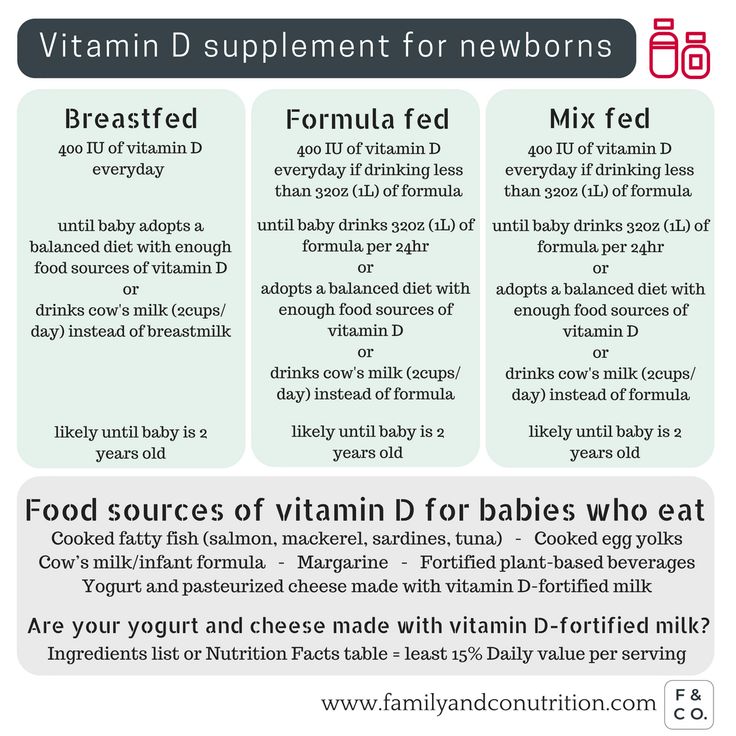
- Fried foods are not good choices for babies. If you offer them at all, do so rarely.
- Avoid feeding your baby juice unless it is fresh-squeezed.
- By now, your baby’s diet should include grains, fruits, vegetables, and meats, and they should be eating two to three meals a day.
- In addition to rice, barley, or oat cereal, you can introduce grain products your baby can grab, such as toast, crackers, and dry cereal. Avoid any colorful, sugary cereals.
- Sit baby in their high-chair for feeding time. If they eat finger foods while crawling around, they are more likely to choke.
- You’re not done with breast feeding or bottle feeding. Your baby is starting the transition, but breast milk and formula are still key.
- Pureeing or mashing vegetables may make them easier for your baby to eat when they are first transitioning from a liquid diet to solids.
13 Best Finger Foods for Baby
Introducing finger foods for baby is an exciting and nerve-racking time. Between the mess, possible allergies and potential choking hazards, it’s enough to give some parents white knuckles as they hover over the high chair. But while you should certainly exercise caution, there are lots of great baby finger food ideas that will make mealtime fun and nutritious, and let your growing child practice the important art of self-feeding.
Between the mess, possible allergies and potential choking hazards, it’s enough to give some parents white knuckles as they hover over the high chair. But while you should certainly exercise caution, there are lots of great baby finger food ideas that will make mealtime fun and nutritious, and let your growing child practice the important art of self-feeding.
In this article:
When can babies eat finger foods?
Baby finger food safety
How to introduce new finger foods for baby
Best finger foods for baby
When Can Babies Eat Finger Foods?
There’s no hard and fast rule in terms of when babies can start eating finger foods, says William Dietz, MD, PhD, director of the Sumner M. Redstone Global Center for Prevention and Wellness at the Milken Institute School of Public Health at the George Washington University in Washington, DC, and co-editor of the American Pediatric Association’s (AAP) Nutrition: What Every Parent Needs to Know. Rather than focusing on baby’s age, says Dietz, “the first indicator you should look for is that the baby is interested.” So how can you tell when baby’s interest is piqued? Reaching for the food as you’re feeding her, grabbing the bowl or spoon, putting the spoon in her mouth and fussing when she sees you eat (because she wants in!) are all signs your child may be ready. “Babies generally want to feed themselves,” Dietz says. “That’s a normal drive.”
Rather than focusing on baby’s age, says Dietz, “the first indicator you should look for is that the baby is interested.” So how can you tell when baby’s interest is piqued? Reaching for the food as you’re feeding her, grabbing the bowl or spoon, putting the spoon in her mouth and fussing when she sees you eat (because she wants in!) are all signs your child may be ready. “Babies generally want to feed themselves,” Dietz says. “That’s a normal drive.”
Being able to sit independently is another good clue that babies are physically ready to try finger foods, says Susan M. McCormack, MA, senior speech language pathologist at Children’s Hospital of Philadelphia and a board-certified specialist in swallowing and swallowing disorders. If they can sit up in the high chair, then they might be ready to try their hand at finger foods.
Some guides suggest waiting to introduce baby finger foods until your child has mastered a pincer grasp—the ability to pick up small objects between the thumb and forefinger—but Dietz says this isn’t totally necessary. “Initially when children start to feed themselves, they don’t have a pincer grasp,” he says. “So they’re using their whole hand and putting their hand in their mouth. And that’s fine.”
“Initially when children start to feed themselves, they don’t have a pincer grasp,” he says. “So they’re using their whole hand and putting their hand in their mouth. And that’s fine.”
If you’re waiting for your infant to sprout teeth before moving on from purees, think again. “Babies don’t need teeth to learn to eat solids and learn to chew,” McCormack says. Those strong little gums are perfectly capable of mashing up soft solids—if you’ve ever let baby teethe on your finger, then you have some idea of just how powerful they are!
Baby Finger Food Safety
When choosing the best finger foods for baby—whether you’re starting at 6 months or 9 months—experts agree that it’s best to begin with small pieces of soft food that dissolve easily.
As your infant grows and becomes comfortable eating finger foods, you can branch out, McCormack says. “As a baby develops better tongue patterns to control food pieces as well as more mature chewing, he can better ‘chew’ the foods that break apart, like pieces of fruits and vegetables. A one-year-old can also bite off pieces of food that a 6-month-old can’t.”
A one-year-old can also bite off pieces of food that a 6-month-old can’t.”
Avoid giving baby finger foods that are large, sticky or don’t dissolve easily, because they’re potential choking hazards, Dietz warns. He suggests steering clear of foods like hot dogs, carrots, nuts, grapes, popcorn, candy and globs of peanut butter.
Another thing to keep in mind when you’re picking out the best finger foods for babies is that a lot of adult foods—particularly snacks—can be super salty. “Often parents will doctor a food so it appeals to their tastes, and their taste may have bigger amounts of sodium than a baby’s taste,” Dietz says. When preparing food for baby, leave out the salt whenever possible. (You can always add it separately to your portion if you’re cooking for the family).
How to Introduce New Finger Foods for Baby
When babies first start on finger foods, breast milk and formula will still be their main source of nutrition, followed by purees. You should continue to spoon-feed your child initially, “but during the feeding process, they should also be allowed to feed themselves,” Dietz says. Put some finger food on her high-chair tray and let her try to get it into her mouth in between the spoonfuls of food you’re feeding her. If she gets really frustrated, go ahead and help her out.
Put some finger food on her high-chair tray and let her try to get it into her mouth in between the spoonfuls of food you’re feeding her. If she gets really frustrated, go ahead and help her out.
Most important, follow your child’s cues and “let your baby be the guide,” McCormack says. If he doesn’t respond positively, take a step back and try again later. But keep in mind that babies often crinkle up their faces when they try something new, which can look like they don’t like something, Dietz says. It can take up to 20 times before they’re used to certain foods. “Parents shouldn’t force food, but they should be persistent in offering,” Dietz says.
McCormack also suggests easing into finger foods by offering thicker purees with a bit of texture to them. “Try alternating bites of the smooth puree with a slightly thicker or mashed food to help your baby get used to the new textures in her mouth,” she says.
Remember, too, that this is a messy process. Parents might want to lay newspaper or an easy-to-clean vinyl tablecloth on the floor, since it’ll be a while (like, years) before your kid manages to get more food in his mouth than on the floor, Dietz advises.
Finally, never leave baby unattended while she’s eating, and keep an eye out for signs of choking. It may be tempting to hold off on introducing finger foods until your child is older, but helping baby develop this skill has multiple benefits, McCormack says, including “development of independence, fine motor skills and self-feeding skills, as well as development of oral patterns to support texture progression.” Whether you start baby finger foods at 6 or 9 months, just follow baby’s lead and let him have fun with it.
Best Finger Foods for Baby
If you’re looking for baby finger food ideas, think about options that are soft, small and easily gummed. Here are a few of the best finger foods for baby to get started—including finger foods for baby with no teeth! While the same finger foods are as appropriate for a 6-month-old as they are for a one-year-old baby, you can begin to offer slightly larger pieces that they can bite off themselves as they become more confident.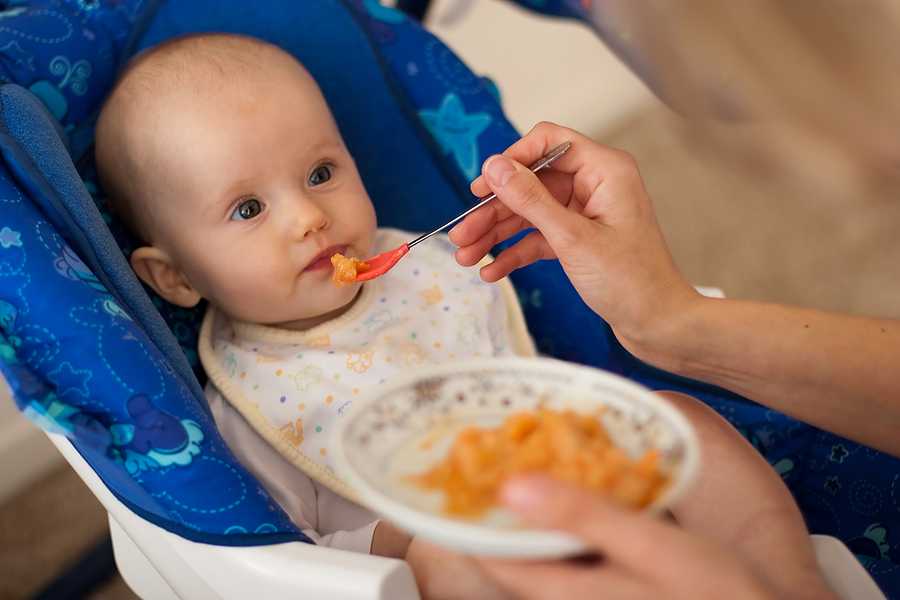 Stick with these healthy options, and you’ll start baby off on the right path for healthy eating.
Stick with these healthy options, and you’ll start baby off on the right path for healthy eating.
Image: The Bump
1. Puffs and dry cereal. Puffs and O-shaped dry cereal are some of the most popular first finger foods for good reason: They let baby practice the pincer grasp by picking up one at a time. And as McCormack explains, they also “mix well with saliva and are easy for the infant to manage in their mouth without choking.”
2. Teething biscuits and lightly toasted bread. Teething biscuits and small pieces of lightly toasted bread are another great starter finger food, since they soften quickly. Just note that some breads can turn gummy and stick in baby’s mouth; lightly toast the bread and cut into very small pieces to avoid a choking hazard. As baby gets older (around 9 to 12 months), you can offer slightly larger pieces or serve bread topped with mashed banana or avocado, or a super-thin layer of hummus or peanut butter.
3. Scrambled eggs. Doctors used to advise waiting to introduce eggs, but the AAP now recommends early exposure to potentially allergenic foods. Which is great news, since scrambled eggs are an ideal early finger food! Keep your love of runny yolks to yourself for now, however, and cook those eggs thoroughly, cut into small pieces and avoid adding salt.
Scrambled eggs. Doctors used to advise waiting to introduce eggs, but the AAP now recommends early exposure to potentially allergenic foods. Which is great news, since scrambled eggs are an ideal early finger food! Keep your love of runny yolks to yourself for now, however, and cook those eggs thoroughly, cut into small pieces and avoid adding salt.
4. Soft fruit. Very ripe fruit is naturally soft, making them some of the best finger foods for babies. Ripe banana, peach, watermelon, raspberries, blueberries and cantaloupe cut into small pieces are all great finger food options.
5. Avocado. A rich source of omega-3 fatty acids—which can help boost baby’s brain development—avocados are, like puffs, often one the first baby finger foods, even when your little one has no teeth. Be warned: Avocado can get messy fast, but it’s well worth it (and can result in some hilarious pics for the baby album).
6. Pasta. Though recipes often recommend cooking pasta al dente, when it comes to feeding baby, you’ll want to slightly overcook it so it’s nice and soft. To start, try small pasta shapes like orzo or mini shells, or cut up fusilli or penne. Initially serve it plain, but as baby is introduced to more foods you can toss the pasta in a little butter, olive oil or low-sodium tomato sauce.
To start, try small pasta shapes like orzo or mini shells, or cut up fusilli or penne. Initially serve it plain, but as baby is introduced to more foods you can toss the pasta in a little butter, olive oil or low-sodium tomato sauce.
7. Tofu. Whether cooked or uncooked, tofu is a wonderful plant-based source of protein and a perfect finger food for babies. Opt for firm tofu, which is still quite soft, as opposed to soft or silken tofu, which will likely fall apart in baby’s hand and frustrate her.
8. Cooked vegetables. Though it will be a while before baby can hit the crudités platter, cooked vegetables make excellent baby finger foods. To get the most nutrients out of your vegetables, steam or roast them until soft, and, of course, cut them into small pieces. Try sweet potato, carrot, broccoli, cauliflower or beets (opt for yellow beets for less mess) to start. As baby gets bigger, you can offer steamed carrot sticks or peeled, roasted sweet potato wedges.
9. Cheese. If baby has shown no signs of a dairy allergy, then it’s perfectly safe to introduce soft cubes of cheese as early as 6 months. Opt for small bites of a pasteurized cheese that’s soft but not overly sticky or stinky, like Monterey Jack or cheddar.
10. Beans. Looking for more protein-rich, vegetarian baby finger foods? Try beans. Opt for canned, low-sodium beans for convenience, or soak and cook dry beans yourself to save money (they’ll freeze well too!). When first introducing beans, smash them just a bit between your fingers before serving to baby.
11. Homemade muffins. While store-bought muffins are often loaded with sugar, there are plenty of healthy muffin recipes out there. Use whole-wheat flour, sweeten with applesauce instead of sugar and add healthy ingredients like mashed banana or grated zucchini. Bake in a mini muffin tin or use a standard-size tin, and, once baked, break off into small pieces for baby.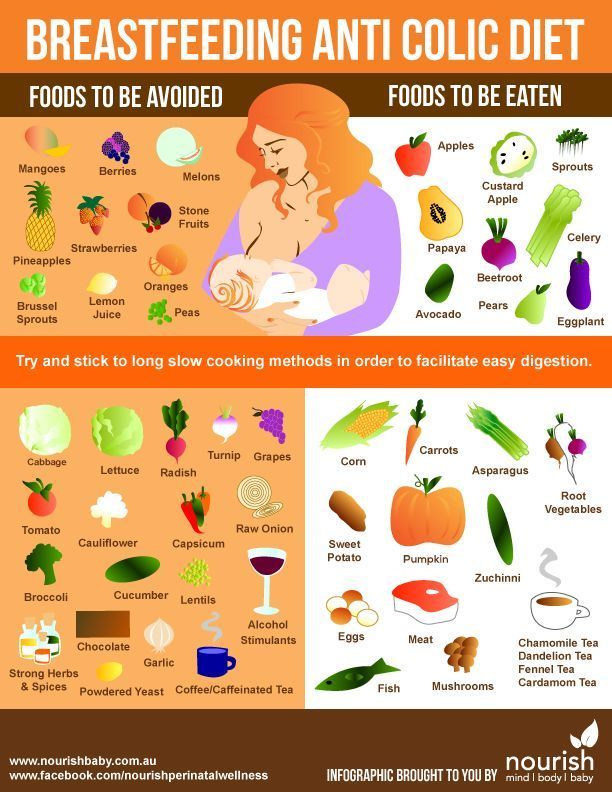
12. Meat. After soft foods, diced chicken breast and ground beef are pediatrician-approved next-stage finger foods for baby. Just make sure they’re thoroughly cooked and cut into very small pieces.
13. Fish. Fish is another allergenic food that doctors now say can be introduced before baby is a year old. Be sure it’s thoroughly cooked, and opt for a low-mercury fish like flounder, cod or salmon. Most important, make sure to remove any tiny bones.
Please note: The Bump and the materials and information it contains are not intended to, and do not constitute, medical or other health advice or diagnosis and should not be used as such. You should always consult with a qualified physician or health professional about your specific circumstances.
Plus, more from The Bump:
Baby-Led Weaning Basics
Why Variety Matters in Baby’s First Foods
The Dos and Don’ts of Homemade Baby Food
Food for babies | Medical center "Beloved Doctor"
For the first six months, the best source of nutrition for a child is mother's milk.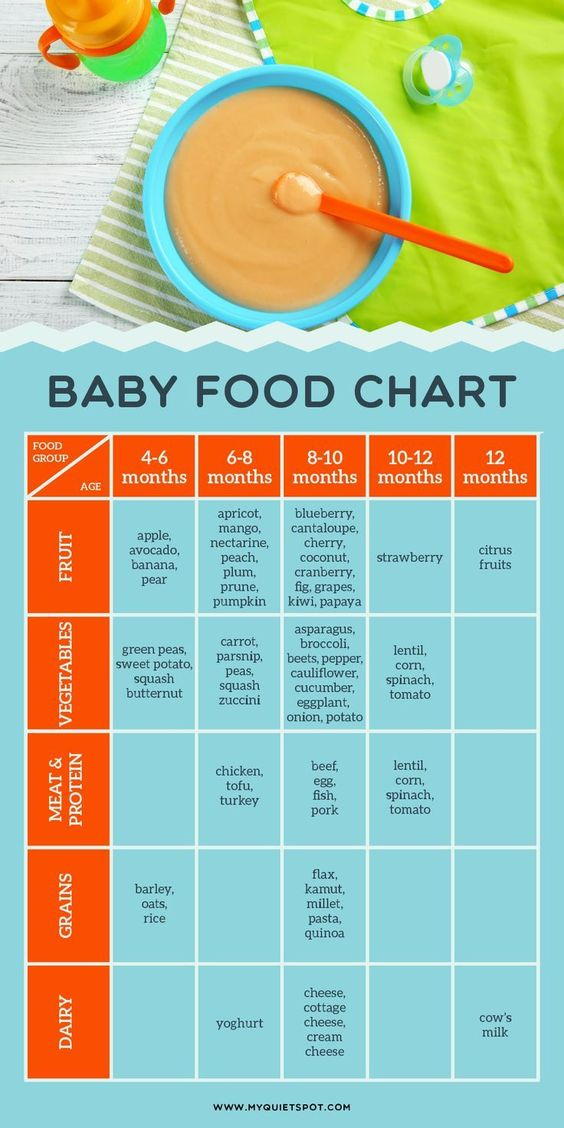 It contains all the necessary elements for the full development of the child in this age period. In some cases, when the mother cannot breastfeed, the baby is fed with special mixtures.
It contains all the necessary elements for the full development of the child in this age period. In some cases, when the mother cannot breastfeed, the baby is fed with special mixtures.
However, after that, the baby needs to expand the diet for the full growth and development of the body.
Complementary food is a range of foods that a child should receive in addition to mother's milk and formula after the first six months of birth. Foods that are denser than milk can be used as complementary foods. Complementary foods contribute to the gradual transfer of the child to the common table. However, it should be remembered that complementary foods are not the basis of a child's diet in the second half of life, the main food product is still milk and milk formulas. But already after the first year of birth, dense and thick food becomes the main food, and milk and milk mixtures become an addition to the food.
Complementary foods can be divided into two types:
- Complementary foods for the transitional period. These are products designed to meet the specific nutritional or physiological needs of the infant.
- Homemade food. These are products intended for young children, which are also included in the diet of all family members.
There is also the concept of "supplementary feeding". Supplementary feeding involves additional nutrients that are given to a child up to six months, that is, before the introduction of complementary foods. Supplementary feeding is used to correct nutrition in a number of diseases in children.
Purposes of introducing complementary foods
- Over time, the child needs additional energy, vitamins and microelements for proper growth and development. When introducing complementary foods, the child's daily calorie requirement should be taken into account.
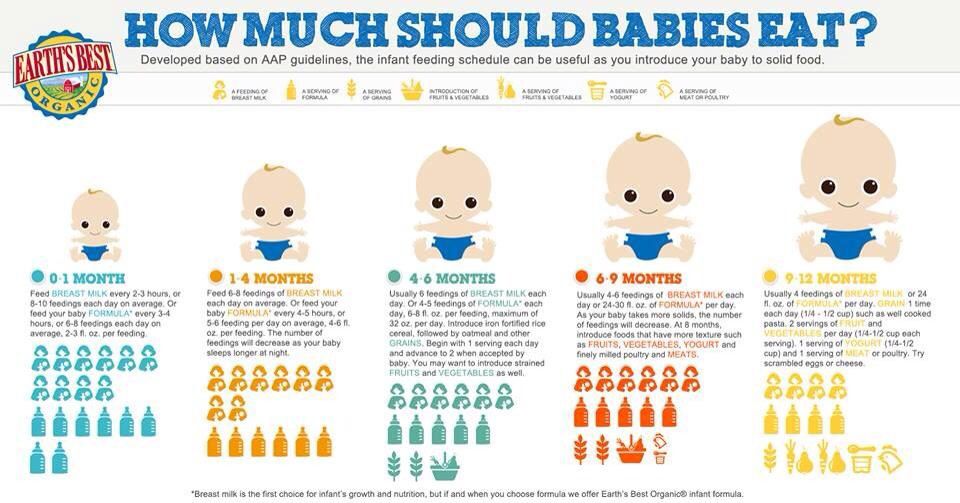 Energy is spent more intensively, but the daily food intake is limited. Therefore, it is necessary to provide the child with food with a higher density and calorie content. The volume and frequency of complementary foods is gradually increased.
Energy is spent more intensively, but the daily food intake is limited. Therefore, it is necessary to provide the child with food with a higher density and calorie content. The volume and frequency of complementary foods is gradually increased. - The transition from liquid food to food from the family table. It's over, right away the child won't be able to eat homemade food. Therefore, at 6 months, the child needs to gradually introduce foods adapted for this age. Complementary foods should be denser than breast milk or formula, but not too thick for the baby to swallow. In this case, mashed dishes are perfect as complementary foods, which can be prepared without problems using blenders and mixers. By 1-1.5 years, complementary foods are replaced with homemade food.
When to start complementary foods?
- The weight of the baby before weaning should be at least 2 times its birth weight.
- Baby stops spitting out solid food.
 In infancy, children have an expulsion reflex of the tongue: the child automatically sticks out his tongue if something different in consistency from the usual food (milk or mixture) enters his mouth. This reflex protects infants from the threat of choking on a foreign body. If the child swallows, and does not spit out thicker food (porridge or mashed potatoes), then complementary foods can be introduced.
In infancy, children have an expulsion reflex of the tongue: the child automatically sticks out his tongue if something different in consistency from the usual food (milk or mixture) enters his mouth. This reflex protects infants from the threat of choking on a foreign body. If the child swallows, and does not spit out thicker food (porridge or mashed potatoes), then complementary foods can be introduced. - The child shows interest in food, becomes more active and opens his mouth at the sight of food, and also asks to be held at the table, trying to taste food.
- The child sits confidently.
- The first teeth appear in the child.
It is optimal to introduce complementary foods at 5-6 months.
Early introduction of complementary foods is not recommended for the following reasons:
-
- If breastfeeding is replaced with complementary foods at an earlier age, then the mother's production of breast milk may be reduced.
 The intestines of children are not ready for the introduction of any other food. Complementary foods may increase the risk of bowel disorders, allergies, etc.
The intestines of children are not ready for the introduction of any other food. Complementary foods may increase the risk of bowel disorders, allergies, etc.
- If breastfeeding is replaced with complementary foods at an earlier age, then the mother's production of breast milk may be reduced.
Late introduction of complementary foods (after 6 months), undesirable for a number of reasons:
-
- Milk and formula cannot fully provide the baby with energy, vitamins and microelements.
-
- Chewing skills do not develop.
-
- Growth and developmental delays may occur.
- Delays in psycho-emotional development.
The timely introduction of complementary foods will strengthen the health of the baby and will contribute to its proper development.
Complementary feeding rules
1. Complementary feeding should begin when the baby is healthy.
2. Do not start complementary foods at the time of routine vaccinations.
Do not start complementary foods at the time of routine vaccinations.
3. Complementary foods should be given with a spoon, not through a nipple.
4. Until the first year of life, salt, sugar and other spices should not be added to complementary foods.
5. New products should be introduced in small quantities, gradually increasing them. Complementary foods should be started with the introduction of one product, gradually moving to mixtures of 2 or more types. If you have an allergy or intestinal disorders to certain types of products, you need to stop taking them. You may not have grown up to them yet. It is best to keep a food diary and record in it all the foods introduced into the diet and reactions to them.
6. Complementary foods should be given warm.
7. From the age of 6 months, you can sit your baby at the common table with his own set of cutlery.
8. From the age of 7 months, gradually accustom the child to drinking cups.
From the age of 7 months, gradually accustom the child to drinking cups.
9. Complementary foods should be porridge or puree. Larger and harder foods should be given later in life.
10. Diet should be varied. Cereals, vegetables, meat are the main products that should be present in the diet.
11. From 8 months you can give food containing small soft pieces. In the daily diet of a child, there should be at least 3 feedings with thick food (up to half a kilogram in total).
Complementary feeding schedule
5-6 months
This is the time to start complementary foods. You need to start it with cereals and vegetable purees, consisting of one type of cereal or vegetables. It is best to use rice, buckwheat or corn grits cooked in water. Vegetable purees are best made from cabbage, potatoes or zucchini, ground with a blender. The serving should not exceed 100-150 g.
7 months
You can make puree from several types of vegetables that are already familiar to the baby. You can also cook vegetable puree soup by adding vegetable oil.
8 months
Start adding fruit purees to your diet. For starters, you can use fruits such as apple, pear, peach. Fruit purees can be mixed with porridge. However, a portion of vegetables and fruits should not exceed 100-120 g. If you gave your baby 60 g of vegetable puree, then fruit puree should also account for no more than 60 g.
At this time, you can start giving your child kefir and cottage cheese. It is best if these products are prepared at home.
9 months
Complementary foods containing meat can be started. It is better to use beef, rabbit or turkey. Lamb up to a year can cause allergies. The meat must be boiled or steamed and mashed using a meat grinder or blender. You can also buy ready-made canned meat for children. To begin with, meat puree can be mixed with vegetable puree, in which there will be less than one teaspoon of meat puree. Gradually, you can come to 3-4 teaspoons of mashed meat per day (50 g).
Lamb up to a year can cause allergies. The meat must be boiled or steamed and mashed using a meat grinder or blender. You can also buy ready-made canned meat for children. To begin with, meat puree can be mixed with vegetable puree, in which there will be less than one teaspoon of meat puree. Gradually, you can come to 3-4 teaspoons of mashed meat per day (50 g).
10 months
Meat is constantly present in the diet. One or two days a week, instead of meat, you can give your child fish in the same grated form. In this case, the first portion of the new product should be half a teaspoon. A full serving is 50 g. It must be remembered that fish can cause allergies if you start giving it to a child earlier.
Pumpkin can be added to vegetables. You can also cook borscht and offer it to your baby in the form of mashed soup. To "desserts" you can add berry puree, yogurt and cookies for children.
11 months
You can expand the diet of cereals. Now you can add semolina, oatmeal, wheat, barley porridge. Also at this time, you can serve puree soups with the addition of finely chopped fresh herbs grown on the window or in the garden. At the same time, you can start feeding your baby bread with butter.
12 months
Juices can be administered during this period. Juice is best prepared at home and fresh fruit and diluted with water in a ratio of 1:1. Milk can be added to dairy products. Purees and cereals can be salted using iodized salt.
What are food allergens?
Gluten
Found in oats and rye. In order not to cause an allergic reaction to gluten, you must first introduce gluten-free cereals: rice, buckwheat, corn. Other cereals, breads and biscuits should be introduced after 9 months.
Other cereals, breads and biscuits should be introduced after 9 months.
Cow's milk
Until the age of one, the body of a child cannot properly absorb cow's milk. When preparing porridge with milk, you need to use mother's milk.
Eggs
Only small amounts of yolk can be given to a child up to one year old, since a very common occurrence in children under one year old is an allergy to protein.
Bright vegetables and fruits
Vegetables, fruits and berries in red, orange and yellow colors can cause allergies. They need to be introduced into the diet very carefully, monitoring the reaction of the body.
Remember that proper nutrition during the first year of life affects the child's health and attitude to food in the future. Be careful. The child should eat those products that are recommended by experts for his age.
For detailed consultations, please contact the pediatricians of our medical center!
Let your baby be healthy and happy with tasty and healthy food!
Favorite Doctor recommends!
Weaning tips for babies
search support iconSearch keywords
close communication process. You are now preparing for another exciting milestone - introducing solid foods to your baby's diet. This is an exciting moment when your baby becomes more independent in eating. But, like all other stages of a child's development, this period requires a long adaptation. Like most parents, you probably want to know when to start introducing solid foods and how to introduce solid foods to your baby.
This article contains important information about how to introduce solid foods to your baby's diet (age-appropriate), tips for introducing complementary foods, and methods to help you and your baby transition smoothly to the next level of nutrition.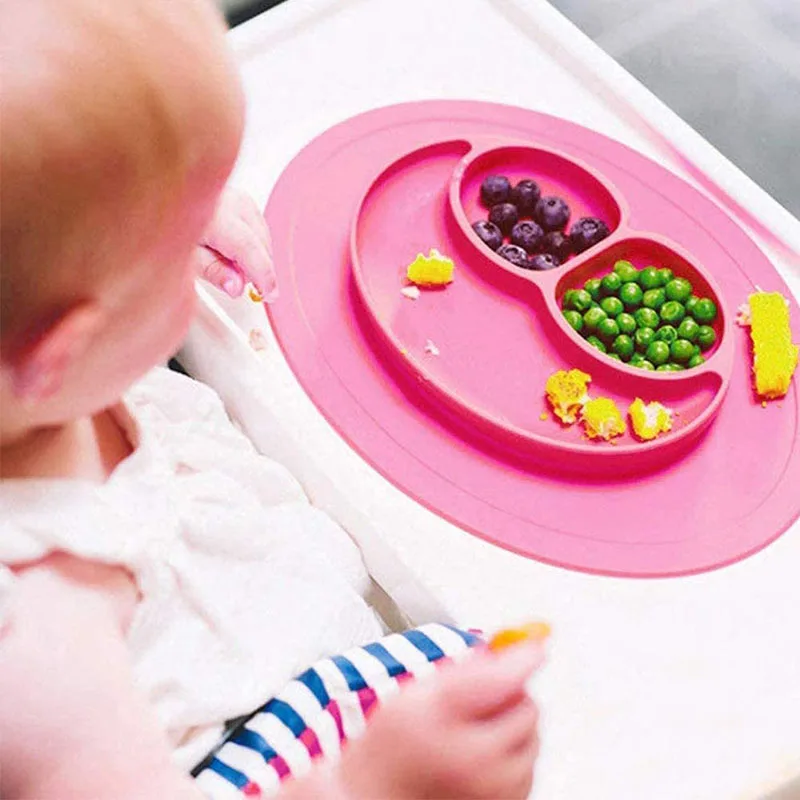
At what age should complementary foods be introduced?
Be sure to check with your doctor when you think your child is ready to introduce new foods to their diet. There is no exact age at which complementary foods should be introduced. However, the introduction of complementary foods to children, both breastfed and bottle-fed, is recommended to start at the age of 4-6 months. At 6 months of age, a baby's energy and mineral needs increase. However, all babies are different and some may be ready for it as early as four months. Four months is the earliest age at which complementary foods can be introduced. Until then, the baby's gastrointestinal tract is not ready to absorb any other food besides breast milk or formula. Only a doctor will be able to assess the individual readiness of each child; no matter what his decision is, it is important to continue breastfeeding, gradually introducing solid foods along with it.
The doctor will try to identify key signs that your baby is ready to eat solid foods: [1]
- The baby can sit up without help or can sit on mom's lap and hold her head.

- The “spoon push” reflex, a natural reaction of rejection of food, in which the child pushes the spoon out with the tongue, has disappeared (the child no longer sticks out his tongue when eating).
- The child has an active food interest (desire to try something from the table while adults are eating).
Once your baby has mastered the skills necessary for independent feeding, including holding his head well, you can begin to introduce more solid foods into the diet.
Your baby's first foods
The moment you've been waiting for is finally here: your baby is ready to try solid food! Usually the products of the first complementary foods are vegetables and cereals.
If the child is healthy, has no digestive problems and is gaining weight well, then, as a rule, complementary foods start with the introduction of vegetables.
Monocomponent vegetable purees are good for the first feeding.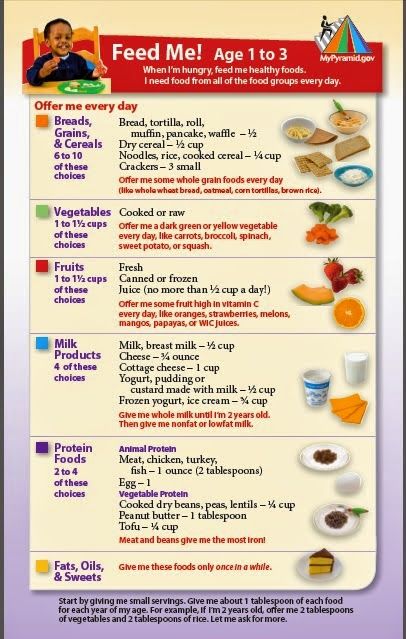 Vegetables are a source of organic acids, potassium, iron, fiber. It is recommended to start vegetable complementary foods with zucchini, broccoli and cauliflower. Initially, vegetable puree should consist of one type of vegetable. Then you can make a combination of different vegetables. Start with 1 spoon, then bring the volume to 180 grams. By the year, the amount of vegetable purees consumed per day is 200 grams.
Vegetables are a source of organic acids, potassium, iron, fiber. It is recommended to start vegetable complementary foods with zucchini, broccoli and cauliflower. Initially, vegetable puree should consist of one type of vegetable. Then you can make a combination of different vegetables. Start with 1 spoon, then bring the volume to 180 grams. By the year, the amount of vegetable purees consumed per day is 200 grams.
If the child is underweight or anemic, industrial cereals can be given as the first complementary food. As the first cereals, in order to avoid allergic reactions, it is recommended to introduce dairy-free gluten-free cereals. Mix one to two tablespoons of single-grain cereal with breast milk, or infant formula, or water. If the child is breastfed, give him complementary foods only after the main feeding, so that the child can first get enough breast milk; keep doing this until he is about
[2]
Once your child is comfortable with their first meal, continue to introduce new foods such as fruit purees, cottage cheese, eggs, dairy products, and meat and fish purees. Before introducing each next product, you must wait three to five days to find out if the child is allergic to the previous one.
Before introducing each next product, you must wait three to five days to find out if the child is allergic to the previous one.
Steaming!
The inclusion of various foods in the diet is very important for the formation of taste habits in the baby. Steam a variety of healthy meals!
Steaming is one of the healthiest ways to prepare baby food. Steamed products are very soft and juicy, unlike fried products, which, of course, is very popular with children. And most importantly, steamed foods preserve the most important vitamins and minerals.
Make healthy cooking easy and enjoyable with the Philips Avent 4 in 1 Steamer Blender. The 4 in 1 healthy baby food maker allows you to steam and grind food in one jug. In addition, with the Philips Avent Steamer Blender, parents can make solid foods for babies of all ages, from purees to chunks. Jug with a volume of 1l. designed to cook several servings at a time. So you can prepare several meals at once to feed your baby now, and also freeze the puree for next time in a special container that comes with the steamer. The defrost and keep warm functions will help you prepare lunch or dinner for your baby even faster.
So you can prepare several meals at once to feed your baby now, and also freeze the puree for next time in a special container that comes with the steamer. The defrost and keep warm functions will help you prepare lunch or dinner for your baby even faster.
The 4 in 1 Steamer Blender also comes with a recipe booklet developed with pediatric nutritionist Emma Williams. In the brochure you will find interesting recipes for preparing tasty and fresh children's meals, as well as useful tips on the introduction of complementary foods and interesting menu ideas. Instill healthy habits in your baby from an early age for healthy development.
In addition to the joy that your child will experience from a change in diet, it is important to be aware of the various food allergies that can occur during the introduction of complementary foods. Experts recommend starting to introduce commonly known food allergens when the baby is 4-6 months old. In addition, recent studies have shown that with a later introduction of complementary foods in children, the risk of developing food allergies increases, therefore, it is necessary to introduce such foods into the baby’s diet on time and not put them off for later. The most well-known G8 food allergens include: [2] [3]
The most well-known G8 food allergens include: [2] [3]
- cow's milk;
- chicken eggs;
- fish;
- seafood;
- nuts;
- peanuts;
- wheat;
- soybeans.
If you or your family members have a food allergy, be sure to consult your pediatrician for the best solution for introducing the foods listed above to your child's diet.
In addition to introducing new foods into the child's diet, it is also necessary to teach him to drink water from the age of 6 months. During the first six months of a child's life, mother's milk provides him with the necessary amount of fluid, even in hot climates. But once your baby is 6 months old, you can start giving him little by little to drink from a non-spill cup.
Check out Avent's Soft Non-Spill Training Cup from the Natural range with comfortable handles to help your child learn to drink without help. It is easy to drink from it, because the liquid begins to flow out only when the child bites or sucks on the spout of the cup. The design of the cup makes it easy to hold with little hands.
The design of the cup makes it easy to hold with little hands.
From pureed to finely chopped foods
Once your child has mastered the motor skills needed to eat more solid foods, you can move on to finely chopped foods. Each child is different, but usually chopped vegetables and meat can be introduced into the diet from nine months. [4]
When you introduce crushed foods into your child's diet, try to get your child to take an active part in family meals. The baby can be offered boiled vegetables, pieces of soft fruit, well-boiled pasta, or small pieces of chicken.
Remember to check that the ground food is soft and well cooked so that the child can easily grind it into a mush with his mouth. Meat, for example, has a tougher structure and fibers, and therefore requires more thorough grinding compared to fruits that are delicate in texture.
With the Philips Avent 4 in 1 Steamer Blender, you can customize your food consistency from puree to chunks. Also, the recipe book that comes with the double boiler will allow you to easily choose the right recipe for the age of the child.
Also, the recipe book that comes with the double boiler will allow you to easily choose the right recipe for the age of the child.
Tips on how to start introducing solid foods to your baby
Here are the main recommendations for introducing complementary foods to infants. As you introduce solid foods into your child's diet, we also recommend following other tips to help your child get used to the new food: [1]
- Offer food only when the child wants it. In a quiet environment or when other family members are having lunch, offer your baby a new food if he wants to try it.
- Introduce a new product in small portions in the morning. A new product should be administered in the morning to monitor possible reactions to the product. Remember that the introduction of new foods into the diet should not be considered a complete meal for the child. It is only about giving the child the opportunity to taste different foods, as well as to get a feel for their structure, gradually increasing their portions as the baby grows older.

- Offer your child a new product only when they are healthy. Do not introduce new foods when the child is sick or during the vaccination period.
- If the child does not like the product, postpone the tasting until a later date. This is a new experience for your baby, associated with new tastes and sensations. Therefore, do not be discouraged and do not worry if the child did not like the food the first time! Simply postpone taking this product until a later time.
- Never leave your child alone with food. Although the child is already taking the first steps in independent nutrition, this does not mean that he can be completely independent.
- Do not give your child foods that are too hard or slippery, rounded or choking. Such precautions will prevent the child from suffocation. Any rounded foods, such as grapes or carrots, should be cut into two or four pieces.
Goodbye liquid diet!
Proper weaning is an unforgettable experience for you and your baby.

